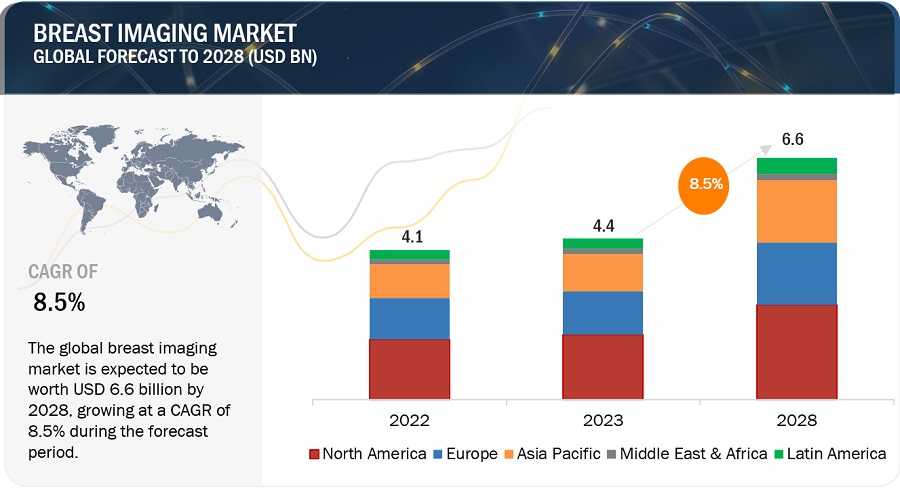According to the new market research report "Breast
Imaging Market by
Type (Ionizing Technologies (Mammography, Digital Mammography, 3D Mammography,
MBI, PET-CT, CBCT, PEM) Non-ionizing Technologies (Breast MRI, Breast Ultrasound,
AWBU, Breast Thermography, Optical Imaging)) - Forecast to 2021",
published by MarketsandMarkets™,
analyzes and studies the major
market drivers, restraints/challenges, and opportunities in North America,
Europe, Asia-Pacific, and the Rest of the world (RoW).
Don’t miss out on business opportunities in Breast Imaging Market.
Speak to our analyst and gain crucial industry insights that will help your business grow: https://www.marketsandmarkets.com/speaktoanalyst.asp?id=897
Based on type, the global breast imaging market is
segmented into ionizing breast imaging technologies and non-ionizing breast
imaging technologies. The ionizing breast imaging technologies segment is
subsegmented into analog mammography, full-field digital mammography (FFDM), 3D
breast tomosynthesis, positron emission tomography/computed tomography
(PET/CT), molecular breast imaging/breast-specific gamma imaging (MBI/BSGI),
cone-beam computed tomography (CBCT), positron emission mammography (PEM), and
electric impedance tomography. The non-ionizing breast imaging technologies
segment includes breast MRI, breast ultrasound, optical imaging, automated
whole-breast ultrasound (AWBU), and breast thermography.
Objectives of the study:
- To define, describe, and forecast the breast imaging market on the basis of type
- To provide detailed information regarding major factors influencing growth of the market (drivers, restraints, opportunities, and industry-specific challenges)
- To analyze opportunities in the market for stakeholders and provide details of the competitive landscape for market leaders
- To forecast revenue of the market segments with respect to four regions, namely, North America, Europe, Asia-Pacific, and the Rest of the World
- To strategically profile the key players and comprehensively analyze their market shares and core competencies
- To track and analyze competitive developments such as new product launches and product enhancements; agreements, partnerships, and collaborations; mergers and acquisitions; and R&D activities in the breast imaging market
Browse and in-depth TOC on "Breast Imaging Market"
107 – Tables
39 - Figures
150 - Pages
View more detailed TOC @ https://www.marketsandmarkets.com/Market-Reports/breast-imaging-technologies-market-897.html
107 – Tables
39 - Figures
150 - Pages
View more detailed TOC @ https://www.marketsandmarkets.com/Market-Reports/breast-imaging-technologies-market-897.html
On
the basis of type, the global breast imaging market is segmented into two major
categories, namely, ionizing technologies and non-ionizing technologies.
Ionizing technologies are further segmented into eight subsegments, namely,
analog mammography, full-field digital mammography (FFDM), 3D breast
tomosynthesis, positron emission tomography/computed tomography (PET/CT),
molecular breast-specific gamma imaging (MBI/BSGI), cone-beam computed
tomography (CBCT), positron emission mammography (PEM), and electric impedance
tomography. The 3D breast tomosynthesis segment is expected to grow at the
highest CAGR in the next five years, owing to the increasing regulatory
approvals for 3D breast tomosythesis systems, benefits offered by these systems
over other technologies, and higher patient accessibility offered by these
systems.
The
non-ionizing breast imaging technologies segment is classified into five
subsegments, namely, breast MRI, breast ultrasound, automated whole breast
ultrasound (AWBU), breast thermography, and optical imaging. The automated
whole-breast ultrasound (AWBU) segment is expected to grow at the highest CAGR
in the next five years, owing to benefits such as high reproducibility, high
resolution power with 3D capability, lower false positives, and faster imaging.
Request
for Free Sample Report @ https://www.marketsandmarkets.com/requestsample.asp?id=897
This
report studies the breast imaging market over the forecast period of 2016 to
2021. The market is expected to reach USD 4.14 Billion by 2021, at a CAGR of
8.5% from 2016 to 2021. A number of factors such as rising incidence of breast
cancer globally, growing government investments and funding for breast cancer
treatment and related research, increasing awareness about early detection of
breast cancer, rising geriatric population, technological advancements in
breast imaging modalities, and launch of advanced breast imaging systems
capable of detecting cancer in women with dense breast tissues are driving the
growth of the global breast imaging market. However, high installation cost of
breast imaging systems, side effects of radiation exposure, and errors in
breast cancer screening and diagnosis are some of the major factors restraining
the growth of this market. In addition, stringent regulatory approval
procedures and unfavorable reimbursement scenario in developing countries are
expected to further restrain the growth of this market in the coming years.
The
breast imaging market is segmented into four major regional segments, namely,
North America, Europe, Asia-Pacific, and the Rest of the World. In 2016, North
America is estimated to dominate the global breast imaging market, majorly due
to the rising incidence of breast cancer, favorable reimbursement scenario,
ongoing technological advancements by market players, implementation of new
breast density notification law in the U.S., rapid growth in geriatric
population, and growing demand for the use of low levels or negligible
radiation doses in the region. On the other hand, the Asia-Pacific market is
expected to grow at the highest CAGR from 2016 to 2021. The high growth in this
market can majorly be attributed to the rising patient population, increasing
healthcare expenditure, higher government spending on breast cancer research
studies, and implementation of several programs focused on creating awareness
about the early detection of breast cancer.
Browse Adjacent
Markets @ Medical
Devices Market Research Reports & Consulting

Comments
Post a Comment